Mobile apps are essential for businesses in today's time and age - quick, mobile access is imperative in keeping up with the competition and rising to the challenges of a fast-paced world. However, having an elastic and reliable back end can be a challenging prospect. That's where the Drupal backend for mobile apps makes the difference.
Drupal CMS offers strong performance and security, simple content creation, and, most importantly, flexibility. Drupal provides a comprehensive backend solution tailored for modern mobile applications, featuring user authentication, scalable content pipelines, and RESTful APIs.
Mobile App Development with Drupal: Why It’s the Ideal Backend Solution
Drupal CMS services can manage complex data structures and relationships. It boasts a strong community that adds to an extensive library of modules. With the emergence of the Drupal decoupled architecture, particularly through the RESTful Web Services module introduced in Drupal 8 and later, it has become easier than ever to utilize Drupal as a decoupled backend, supplying content via APIs to any frontend technology, including mobile applications.
Drupal employs an API-first strategy, making it an effective Drupal backend for mobile apps. Its support for RESTful APIs enables flexible and efficient data transmission, allowing developers to select the best method for their use case, resulting in comparisons such as Drupal JSON API vs REST. This architectural approach reduces the complexity of mobile interfaces and backend systems, thereby improving performance and data accuracy.
As a headless CMS for mobile apps, Drupal thrives in scalability, security, and content management. Drupal's decoupled architecture has made it an appealing option for mobile app development with Drupal.
Why Drupal Backend for Mobile Apps is a Game-Changer?
Drupal development services enable you to develop quick, lightweight, and powerful mobile applications, which we will dive into in this post.
Easy and Convenient Integration
Drupal 8 and beyond have redefined integration with the RESTful Web Services module in the framework, making it simple for other applications to communicate with your Drupal website. This module supports a variety of HTTP methods and includes an authentication mechanism that may be used with modules and resources.
The RESTful API documentation for Drupal includes a guide for developers who are interested in using this feature. Also, the Headless Lightning distribution gives you a foundation for decoupled apps, which are useful for mobile app development.
Sophisticated Content Management
Drupal boasts inimitable content management capabilities, making it perfect for news articles and consulting services. It organizes important information and separates it from less important details. This is even more essential for mobile apps as screens are small and users’ attention is short. Drupal allows you to easily tailor block behavior using custom modules and handle content effectively.
Sophisticated SDKs and Libraries
Drupal's ecosystem is rich in SDKs and tools that may help you create mobile apps faster.
Prominent tools include:
- Waterwheel Swift: A bridge that connects native iOS apps to Drupal.
- Drupal 8 iOS SDK: It is an SDK and sample app for connecting iOS apps with Drupal 8.
- DrupalCloud: It is an Android library for Drupal services.
- DrupalGap: Mobile app design services for Drupal sites based on PhoneGap and jQuery Mobile.
Such tools keep your development process up-to-date and efficient, allowing you to focus on producing excellent apps.
Flawless Synchronization
Synchronize the mobile application and website content with a simple click from the control panel. Mobile apps developed with Drupal allow users to change information quickly and easily, ensuring that everything is in sync throughout all devices. If you're unfamiliar with app creation, you should learn the fundamentals of mobile applications before entering into how Drupal simplifies the entire process.
Effective Architecture and Safety
Drupal allows you to participate in the design process rather than only joining the developers. While WordPress might work exceptionally well for developing a simple blog or a page for a small audience, Drupal is multilingual, allows for a higher degree of customization, and integrates with monitoring and information sources.
Drupal enables you to keep your content and functions relevant in an ever-proliferating and changing market and business environment. Security in Drupal 10 has been further developed with the addition of Cross-Site Request Forgery (CSRF) protection and secure password hashing, providing a solid foundation for mobile application development.
Advantages of Using Drupal as a Backend for Mobile Applications
Drupal offers several benefits when used as a backend for mobile applications. Here are some key advantages:
- Drupal is also renowned for its flexibility, which makes it an excellent option for a mobile app backend. It may be used to ease the inclusion of modules for customized behavior. This is what makes Drupal a helpful foundation for feature-rich mobile applications.
- Drupal comes with a built-in RESTful API, embracing an API-first approach. This allows your mobile app to connect to the backend. For apps on mobile devices, decoupled Drupal services offer a headless CMS that brings more flexibility and beefs up security.
- Developers can utilize numerous Drupal mobile backend tools and modules to enhance app capabilities without needing to start from scratch. This speeds up Drupal mobile app development and allows for greater customization.
- Drupal's modular structure and performance capabilities ensure that your backend develops alongside your user base. Drupal also stands out in terms of security, a common concern with mobile apps, due to its regular updates and established data protection mechanisms. This safeguards sensitive user data and fosters trust among app users.
Conclusion
The Drupal backend for mobile apps offers a unique blend of scalability, versatility, and efficiency that developers will appreciate. Its API-first approach, support for Drupal decoupled architecture, and Drupal mobile backend tools make it an excellent headless CMS for mobile apps. If taking on this design seems too complex or laborious, think about joining professionals with a bunch of pros.
Hire Drupal experts to connect front-end and back-end development so that mobile apps work well, on time, and safely.
FAQ
Frequently Asked Questions
Didn’t find what you were looking for here?

